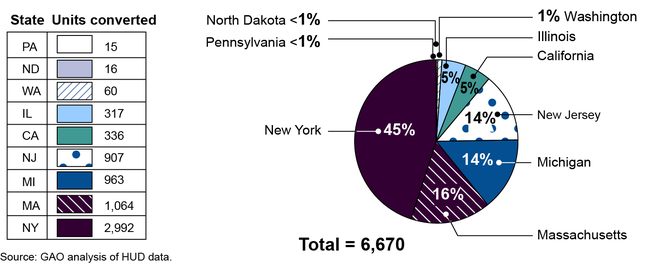HUD Rental Assistance Demonstration: Information on Initial Conversions to Project-Based Vouchers
Highlights
What GAO Found
Conversions to project-based vouchers under the Department of Housing and Urban Development's (HUD) Rental Assistance Demonstration (RAD) program will have a small effect on the percentage of total vouchers (made up of project and tenant-based) that are project-based. Residents with tenant-based vouchers can receive their assistance in any eligible privately owned rental unit, which means if they leave the unit, their assistance goes with them. In contrast, residents with project-based vouchers can only benefit from the assistance if they remain in the specific unit. As of March 1, 2014, property owners had converted a total of 6,670 units to project-based vouchers in nine states. The percentage of vouchers that are project-based including RAD conversions was 3.81 percent, and without RAD, would have been 3.45 percent. Further, the impact of these conversions on the overall long-term percentage of project-based vouchers will be small because the conversions are limited to the remaining 38,000 units assisted through the three designated HUD programs, which is relatively small compared to the over 2 million total outstanding vouchers. As the figure shows, most conversions have taken place in New York, Massachusetts, Michigan, and New Jersey—four states with a large concentration of units that were originally subsidized under designated HUD programs.
Number and Percentage of Units Converted to Project-Based Vouchers through the Rental Assistance Demonstration, by State, as of March 1, 2014

Note: Percentages may not total to 100 percent due to rounding.
Stakeholders GAO interviewed generally viewed the conversions to project-based vouchers as a useful tool in preserving affordable housing. Stakeholders explained that, absent RAD, property owners would have had few or no options for continuing some form of rental subsidy when their contracts expired. Further, RAD conversions provide a stable subsidy for their properties that allows them to better obtain financing. All five owners—representing nine properties GAO contacted—have recapitalized or plan to recapitalize their properties, including refinancing or restructuring their debt, in order to rehabilitate them. Housing organization officials and a housing expert also told GAO that RAD has helped to preserve the number of affordable housing units. PHA officials, property owners, and residents told GAO that these conversions have not adversely affected residents' housing choices.
Why GAO Did This Study
Over the next several years, rental assistance contracts will expire for about 38,000 affordable housing units currently subsidized through three HUD rental programs. Owners of these units would no longer be required to maintain affordable rents or make their units available to low-income residents. Residents in these units are eligible to receive special tenant-based vouchers called tenant-protection vouchers to shield them from resulting rent increases. HUD's RAD program was created in 2011 to preserve affordable housing by, among other things, allowing owners to convert these tenant-protection vouchers to project-based vouchers for units in three designated HUD programs. Project-based vouchers result in a long-term contract between the property owners and PHAs, which administer the vouchers.
The Consolidated and Further Continuing Appropriations Act of 2012 mandated that GAO review these conversions under RAD. This report describes the results of these conversions.
GAO reviewed HUD program documentation and procedures; analyzed data on conversions as of March 1, 2014; and conducted interviews with HUD officials as well as nongeneralizable interviews with four PHAs and five property owners selected based on geography and other factors.
GAO is not making recommendations in this report.
For more information, contact Daniel Garcia-Diaz at (202) 512-8678 or GarciaDiazD@gao.gov.
